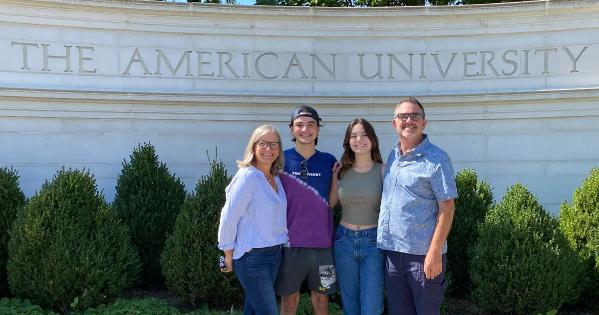SIS Student and CODA Julia Craig Raises Awareness for Deaf and Queer Communities

Growing up as a child of deaf adults (CODA), Julia Craig, SIS/BA ’25, had many experiences that were different from other children her age. Rather than hiding the community in which she was raised, Craig embraces it by bringing awareness of the deaf community to every new space that she enters.
Against the backdrop of National Disabilities Awareness Month in March, we sat down with Craig to learn the ways in which straddling the disabled and abled communities has shaped her, how her queer identity intersects with her lived experiences as a CODA, and how sharing her insights can help people better understand “difference.”
Acquiring Language

As a CODA, Craig learned American Sign Language (ASL) as her first language. After learning English as her second language through reading books with her parents, Craig realized she did not sound like everybody else when talking: “I had to go to speech therapy for many years because I was behind in my spoken English proficiency. On top of that, the grammars and norms of ASL and English are very different. So, I wasn’t confident in my English skills for a very long time. Even now, I still have my frustrations.
“When you go to a regular school, almost all your friends are hearing; they probably have never met a deaf person in their life. So, the more I practiced English outside my home, the more my ASL proficiency went down,” explains Craig. “I realized that others had a hard time understanding my ASL, and that really frustrated me because, if not for anything else, I wanted to know my parents’ language. So, I practiced ASL more.”
Craig’s desire to sharpen her ASL proficiency stemmed from a sense of responsibility that many CODAs possess: “I had to grow up much quicker than everybody else to interpret for my parents. Even if I was upset with them, I had to put my feelings aside when they wanted my help and prioritize their understanding of situations.”
Oscar-Worthy Representation
This responsibility that Craig describes is exemplified in the 2021 Academy Award-winning film CODA. In this coming-of-age movie, a teenage CODA—the only hearing member of the family—tries to balance helping her family’s struggling fishing business with pursuing her own dreams of going to college to become a singer.
Craig says the movie is the first time she has seen an accurate representation of CODAs on screen: “While there are some deaf characters in shows, you rarely see CODAs. If you do, they usually focus on ASL and their deaf parents, but not the CODA identity or the struggles that CODAs have.
“In shows and movies, deaf characters are made to be really likable, but deaf people can be jerks too,” states Craig. “In CODA, I liked how they showed a lot of conflict between the members of the family, because all humans are complicated. They’re not bad. They’re not unlikable. They’re complicated.”
A Safe Space on Campus
Just as CODA was premiering on Apple TV+ in August 2021, Craig came to SIS to pursue a degree in international studies. After learning that her grandfather majored in international relations in college, Craig felt something click in her head: “I had such a strong gut feeling that this was what I wanted to do. And then coming to SIS, I can tell that I’m where I’m supposed to be.”
Apart from her studies, Craig serves as outreach coordinator for AU PRIDE, an LGBTQ+ student group that strives to protect the rights and interests of AU’s queer community while creating a safe space for identifying members to exist free from judgment. Growing up in another community that is constantly misunderstood and mischaracterized, Craig saw an opportunity to bridge the gap between these two identities. On November 29, 2022, Craig hosted an educational seminar that taught AU PRIDE about the intersection of LGBTQ+ identities and the deaf community.

“I’m not ashamed of having deaf parents and speaking ASL; I’m actually very proud of it,” proclaims Craig. “From what I’ve seen, people are very interested in learning ASL. They just don’t know how. So, I thought by teaching how to sign your identity and other interesting signs, it would help motivate students to learn more about ASL and the deaf community.”
Setting the Record Straight
To help strike down common misconceptions about the deaf community, we gave Craig the floor to bring awareness to a few important things: “Number one, a lot of people feel like deaf people cannot teach ASL to people who are just starting to learn. Very untrue. If you want to actually excel and learn about the deaf community and culture, learn from deaf teachers and educators.
“Number two, only learn ASL if you have good intentions. A lot of people learn ASL to sign songs for clout on TikTok. And they only learn a hearing-washed version of the words and not the actual language. ASL is not the subtitle version of English.”

Craig drives home a final point: “Deafness does not need to be fixed. In the medical world, when a parent finds out their child is deaf, doctors immediately say, ‘Here are some cochlear implant pamphlets to read through, and here’s a hearing aid.’ Deafness does not need to be solved, because it wasn’t a problem in the first place. Having a disability can be your identity, and there is nothing wrong with that.”
